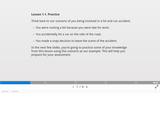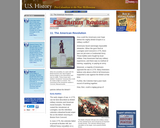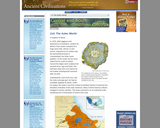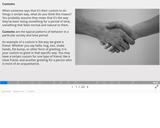
Hit and Run Accident Example Slideshow
- Subject:
- Career and Technical Education
- Criminal Justice
- Material Type:
- Interactive
- Provider:
- Michigan Virtual
- Date Added:
- 07/29/2019

Hit and Run Accident Example Slideshow

Criminology Notecards

Slides on Crime and Society

How could the Americans ever hope defeat the mighty British Empire in a military conflict? Americans faced seemingly impossible obstacles. When the guns fired at Lexington and Concord in 1775, there was not yet even a Continental Army. Those battles were fought by local militias. Few Americans had any military experience, and there was no method of training, supplying, or paying an army.

Criminology Slideshow

The British seemed unbeatable. During the previous 100 years, the British had enjoyed triumph after triumph over nations as powerful as France and Spain. At first glance, the odds were clearly against the Americans. A closer look provides insight into how the underdogs emerged victorious.

Just as developing a coherent foreign policy is problematic in these post-Cold War days, so is the question of defending the country against possible danger from outside its borders. The avoidance of war, as indicated by the 1947 name change from "Department of War" to "Department of Defense" today holds the highest priority, and the hope that the United States can play a role in limiting violent upheavals around the world is reflected in both its foreign and military policies.

It is impossible to know the exact number of American colonists who favored or opposed independence. This section discusses attitudes toward the American Revolution in the colonies

Until the 20th century the country abided by the laissez-faire policy, which required a free market with little intervention from government. With the Great Depression came Keynesian economics, or the opposite belief that the government should manage the economy. Today, United States economic policy lies somewhere in between åÑ government should regulate and sometimes manage, but should allow a free market whenever possible. Political and business leaders disagree on how much control is enough.

Ready to fight at a moment's notice, minutemen began fighting early in the American Revolution. Their efforts at Lexington and Concord inspired many patriots to take up arms against Britain.

On the night of June 16, 1775, a detail of American troops acting under orders from Artemas Ward moved out of their camp, carrying picks, shovels, and guns. They entrenched themselves on a rise located on Charleston Peninsula overlooking Boston. Their destination: Bunker Hill.

Huitzilopochtl, God of the Sun, was the Aztec principal god. He had an insatiable appetite for blood. Under his urging, the Aztecs rose from a band of primitive farmers to become the bloodiest civilization of the early Americas. Many Central America cultures indulged in human sacrifice. The Aztec practiced it on an industrial scale, sacrificing tens of thousands of victims each year.

In the wake of Columbus' historic voyage in 1492, expeditions, especially from Imperial Spain, swarmed into Aztec territory. They came in search of gold and souls gold to enrich the coffers of the Spanish king (and their own), and heathen souls to rescue for Christianity. Within a generation, America's ancient civilizations were crushed. Both the Aztec and Inca Empires collapsed after campaigns lasting just a couple of years. How did they fall so fast? Historians suggest many causes.

During the war years, those Americans not involved in warfare were doing their best just trying to survive. Farmers continued to grow food, artisans continued to practice their trades, and merchants attempted to maintain their businesses. Despite efforts to maintain business as usual, the entire social landscape was changed.

At Valley Forge, there were shortages of everything from food to clothing to medicine. Washington's men were sick from disease, hunger, and exposure. The Continental Army camped in crude log cabins and endured cold conditions while the Redcoats warmed themselves in colonial homes. The patriots went hungry while the British soldiers ate well.

The Battle of Saratoga was the turning point of the Revolutionary War. The scope of the victory is made clear by a few key facts: On October 17, 1777, 5,895 British and Hessian troops surrendered their arms. General John Burgoyne had lost 86 percent of his expeditionary force that had triumphantly marched into New York from Canada in the early summer of 1777.

Nowhere was the victory at Saratoga more noted than in France, which had been tentative in its efforts to assist the Americans. France's interest in the American fight for independence stemmed from France's humiliating defeat during the Seven Years War at the hands of its ancient enemy, England.

Although the American military was still enduring losses in 1780, the French were making a difference. The French navy was disrupting the British blockade. French commanders such as Lafayette and Rochambeau earned the respect and admiration of the American troops.

Slideshow on Changing Rules of Society

Video and audio slideshow on customs and laws